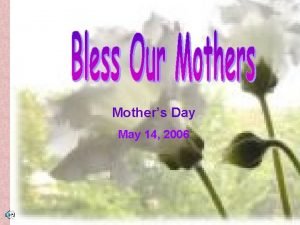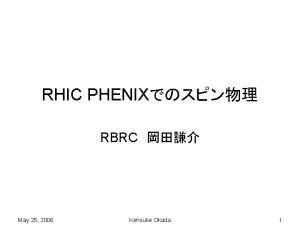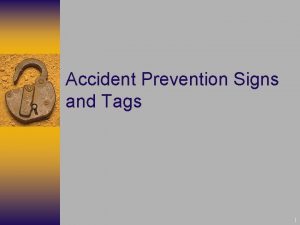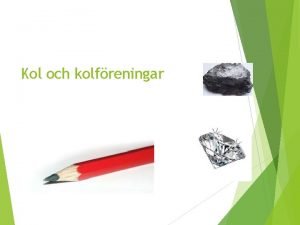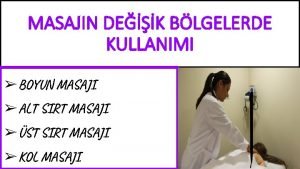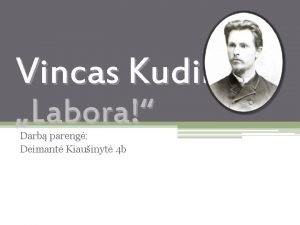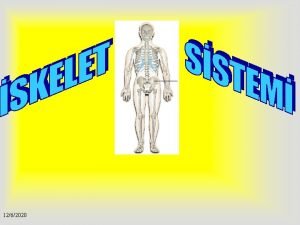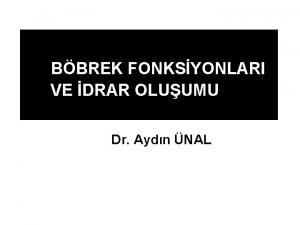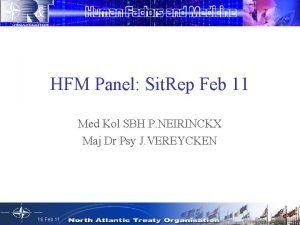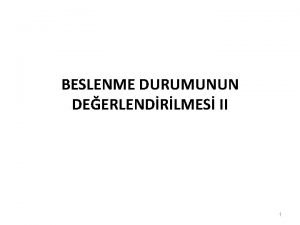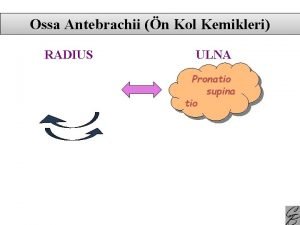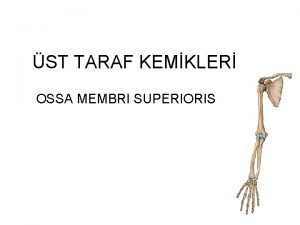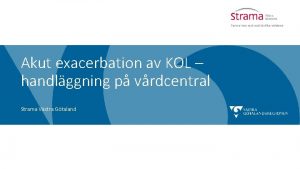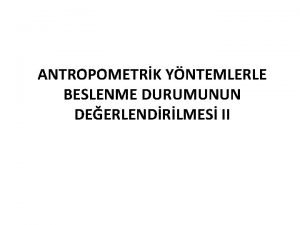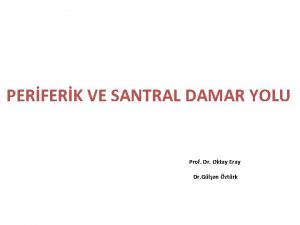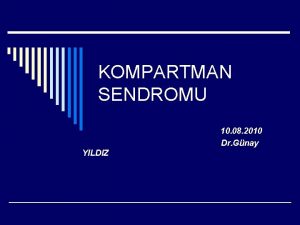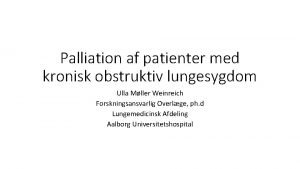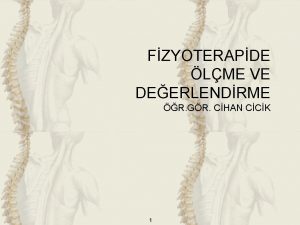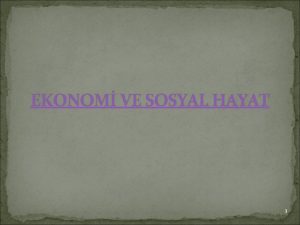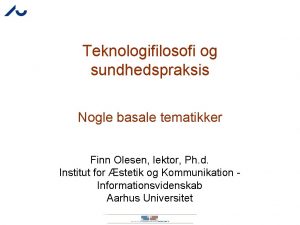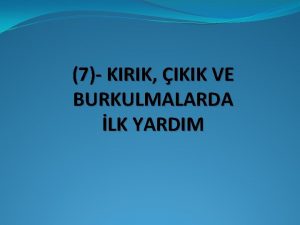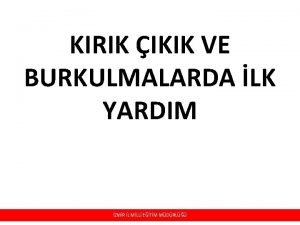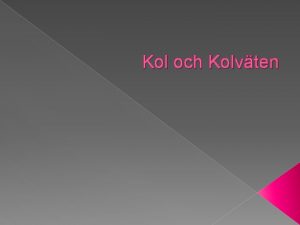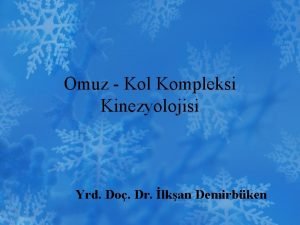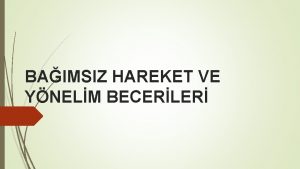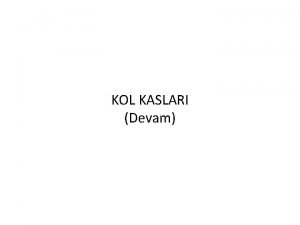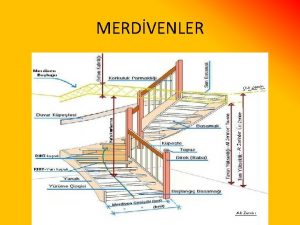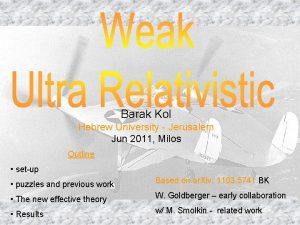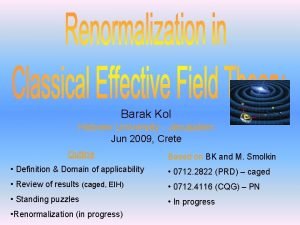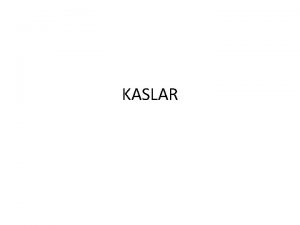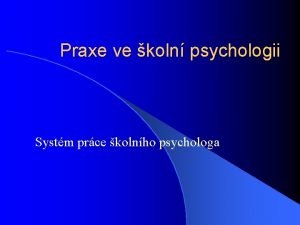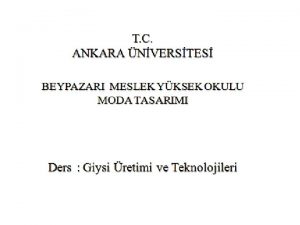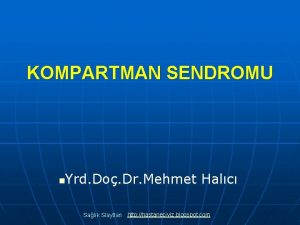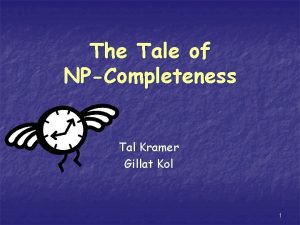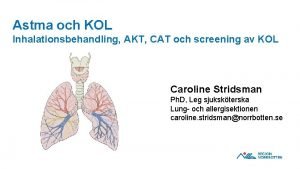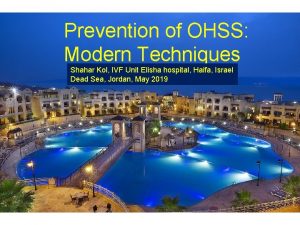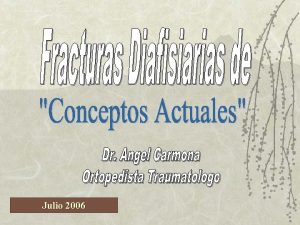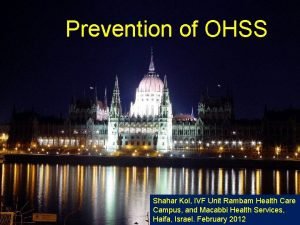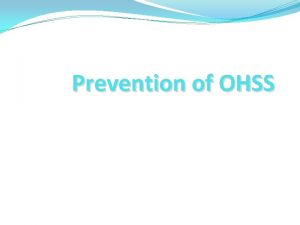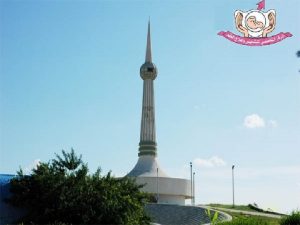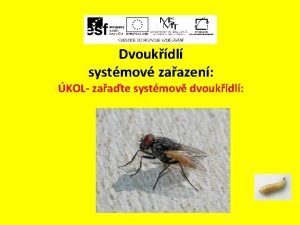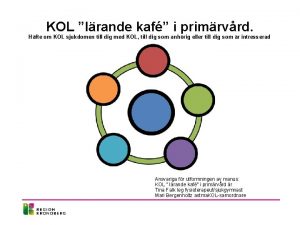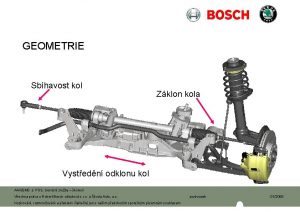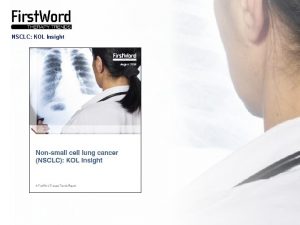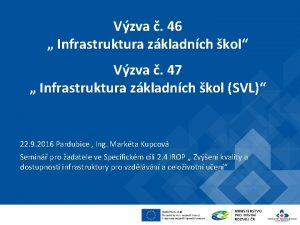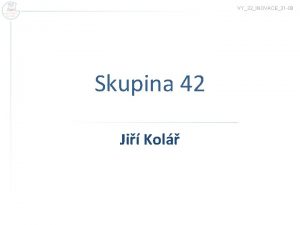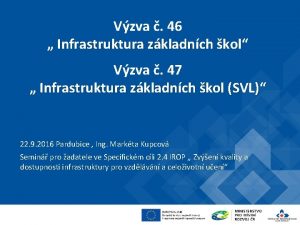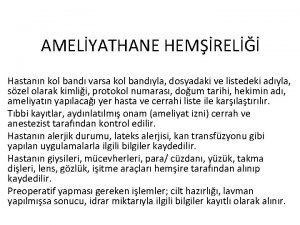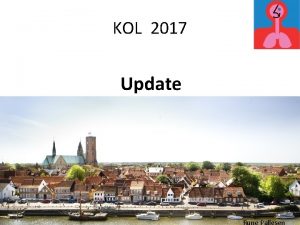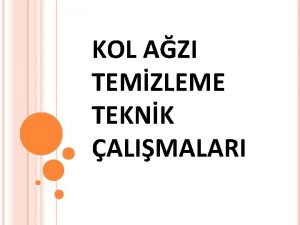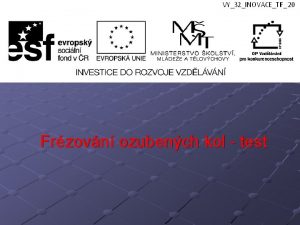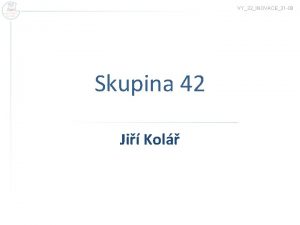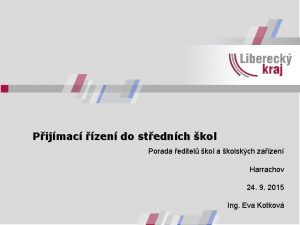Prevention of OHSS S Kol May 2006 OHSS














































- Slides: 46

Prevention of OHSS S. Kol, May 2006

OHSS – scope of the problem • Severe form: 0. 2 -1% of stimulation cycles. • Mortality: 1: 45, 00 to 1: 50, 000 per infertile women receiving gonadotropins. WHO 2001

OHSS: incidence, recent data • Two large trials, 1458 patients, agonistbased protocol, comparing Menopur and Gonal F (Arce and Sorensen, ASRM 2005) • Patients at high risk for OHSS - “dropouts”. • Moderate – severe OHSS: 2%

F&S January 2006 Objective: to determine OHSS incidence in 2, 524 antagonist-bas Objective cycles (1801 patients). Results: fifty three patients ( 2%) were hospitalized because of OH Results 2% Conclusions: clinically significant OHSS is a limitation even in Conclusions antagonist cycles. “There is more than ever an urgent need for alternative final oocy maturation – triggering medication”

Morbidity • An autopsy case of ovarian hyperstimulation syndrome with massive pulmonary edema and pleural effusion. • Case report : delirium associated with ovarian hyperstimulation syndrome. • Cortical vein thrombosis misinterpreted as intracranial haemorrhage in severe ovarian hyperstimulation syndrome: case report. • Subclavian deep vein thrombosis associated with the use of recombinant follicle-stimulating hormone (Gonal-F) complicating mild ovarian hyperstimulation syndrome. • A severe case of ovarian hyperstimulation syndrome: 65 liters of ascites aspirated in an on-going IVFET twin pregnancy. • Central retinal artery occlusion associated with severe ovarian hyperstimulation syndrome. • A case of forearm amputation after ovarian stimulation for in vitro fertilization-embryo transfer. • Stroke in ovarian hyperstimulation syndrome in early pregnancy treated with intra-arterial rt-PA. • Internal jugular vein thrombosis: a late complication of ovarian hyperstimulation syndrome despite mini-dose heparin prophylaxis. and more…

Past predictions of the future • “We don’t like their sound, and guitar music is on the way out” Decca Recordings Co. rejecting the Beatles, 1962. • “Stocks have reached what looks like a permanently high plateau”. Irving Fisher, Professor of Economics. Yale University, 1929. • “$100 million is way too much to pay for Microsoft” IBM 1982. • “Who the hell wants to hear actors talks? ” H. M. Warner, Warner Brothers, 1927. “Severe OHSS will remain a complication of IVF cycles despite all attempts of prevention. ” R. G. Forman, Human Reproduction 14: 2687, 1999. “…absolute prevention will not be possible” García-Velasco et al F&S, March 2006.

Accepted preventive strategies • • • Canceling the cycle Coasting Albumin IV Cryopreservation Recombinant LH Low h. CG dose

Coasting • Most popular choice. • Open questions: for whom? how many days? Safe value to give h. CG? Magnitude of E 2 drop? • Cochrane database: D'Angelo A, Amso N. Coasting for preventing ovarian hyperstimulation syndrome. The Cochrane Database 2002 “There is a lack of randomised controlled trials…there is insufficient evidence to determine if coasting is an effective strategy for preventing OHSS. ”

IV albumin • Conflicting results. • Cochrane database: Aboulghar M, Evers JH, Al-Inany H. Intra-venous albumin for preventing severe ovarian hyperstimulation syndrome. The Cochrane Database of Systematic Reviews 2002: “Clear benefit from administration of intra-venous albumin at the time of oocyte retrieval in prevention of severe OHSS in highrisk cases”. Intravenous albumin does not prevent moderate-severe ovarian hyperstimulation syndrome in high-risk IVF patients: a randomized controlled study. Bellver at al 2003 The questionable use of albumin for the prevention of ovarian hyperstimulation syndrome in an IVF programme : a randomized placebo-controlled trial. Ben-Chetrit et al 2001 Personal communication with Professor Aboulghar: review amendm albumin is ineffective.

Cryopreservation • OHSS can be severe until menses. • Cochrane database: D'Angelo A, Amso N. Embryo freezing for preventing ovarian hyperstimulation syndrome. The Cochrane Database of Systematic Reviews 2002, “insufficient evidence to support routine cryopreservation and insufficient evidence for the relative merits of intra-venous albumin versus cryopreservation“

Recombinant LH • Not available as trigger. • No data on OHSS prevention. • In theory, will not prevent late, pregnancyassociated, OHSS.

Low h. CG dose • Questionable, unreliable. • “Reducing the dose of h. CG does not eliminate the risk of OHSS in a high risk group” Schmidt el al, Fertility Sterility October 2004

“Severe OHSS will remain a complication of IVF cycles despite all attempts of prevention. ” R. G. Forman, Human Reproduction 14: 2687, 1999. Total OHSS prevention can only be achieved by ovulation triggering with a Gn. RH agonist.

The Gn. RHa-induced LH/FSH surge • LH and FSH levels rise 4 and 12 hours post trigger, respectively. • LH surge lasts for 24 hours. • Surge amplitude comparable to physiology. • A single agonist dose reliably triggers ovulation. Itskovitz et al 1991

Luteal phase • Normal early follicular-luteal shift in ovarian steroidogenesis. • Short luteal phase: early luteolysis.

Case-control study (Lewit et al Hum Reprod 11: 1399, 1996) • 16 patients who developed severe OHSS when h. CG was given as trigger (group A). • Each patient underwent at least 1 cycle during which Gn. RH agonist was given as trigger (triptorelin 0. 2 mg, group B). • In group B – no OHSS!!!

Stimulation variables Group h. CG E 2 max (pmol/l) No. oocytes No. h. MG amp 16, 969± 8, 948 28± 11 24± 6 Gn. RH-a 20, 816± 9, 568 36± 14 21± 4 Lewit et al

Oocyte quality Group FZ Atretic GV NVS PB h. CG 6(3%) 8(4%) 10(5%) 180 (84%) 214 11(4%) 15(6%) 19(7%) 7(3%) 205(80%) 257 Gn. RH-a Total Lewit et al

Limitations • Prospective study – ethical dilemma? • Not applicable in agonist-based cycles: unresponsive pituitary. Use antagonists? ? ?

Efficacy Gn. RHa vs h. CG for triggering of final oocyte maturation Fauser et al, JCEM Feb. 2002, 87: 709 • • Objective: Can agonists trigger ovulation as effective as h. CG? Randomized prospective multi-center study. Antagonist-based cycles, normal responders. Outcome measures: number of metaphase II oocytes

Protocol Fauser et al, 2002

Clinical outcome (mean±SD) Triptorelin (n=17) Leuprorelin (n=15) h. CG (n=15) Number of oocytes/subject 9. 8 ± 5. 4 8. 7 ± 4. 5 8. 3 ± 3. 3 Proportion of metaphase II oocyte 72 ± 18% 85 ± 17% 86 ± 17% Fertilization 61 ± 30% 62 ± 23% 56 ± 18% No. of embryos obtained per subject, grades 1 and 2 pooled 2. 7 ± 34% 3. 2 ± 2. 6 3. 3 ± 2. 0 Implantation rate 15 ± 34% 18 ± 37% 7 ± 14% 18% 20% 13% Ongoing pregnancy rate Fauser et al, 2002

Serum concentrations of LH (h. CG), FSH, E 2 and P Fauser et al, 2002

Can this approach prevent OHSS?

Human Reproduction, September 2000 Use of a single bolus of Gn. RH agonist triptorelin to trigger ovulation after Gn. RH antagonist ganirelix treatment in women undergoing ovarian stimulation for assisted reproduction, with special reference to the prevention of ovarian hyperstimulation syndrome: preliminary report: Short communication J. Itskovitz-Eldor et al

Treatment scheme for high responders Day 2 -3 menses Day 6 r. FSH High responder triptorelin 0. 2 mg Rec FSH OPU ganirelix ET Progesteron e

Stimulation characteristics of 8 women with increased risk for developing OHSS and who received 0. 2 mg triptorelin for triggering ovulation Sub. r. FSH (IU) Foll 11 mm 7 1350 22 33 39 E 2 pg/ml Oocytes %MII 2980 29 100 1500 21 3660 14 100 1950 24 3350 30 90 108 a 1875 22 6410 1 100 109 1275 28 7670 52 54 112 1575 34 4050 30 93 126 2175 22 3690 15 67 158 1575 28 3020 16 56 a Empty follicle syndrome No OHSS !!!

Results • Mean no. of follicles>11 mm=25. 1± 4. 5 • Median E 2 (pg/ml)=3675 (range 2980– 7670) • Mean number of oocytes=23. 4 (± 15. 4), 83% MII • Mean number of embryos=15. 4± 6. 6 • 7 ETs from fresh embryos: 1 pregnancy • 17 ETs from frozen-thawed embryos: 4 pregnancies Itskovitz et al, 2000

Median values of serum LH and E 2 after injection of triptorelin 0. 2 mg Time after injection (n=8) Serum LH (IU/l) Serum estradiol (pg/ml) Pre-dose 0. 5 h 2. 4 12. 7 4775 4630 1 h 2 h 4 h 10 -12 h Day of OPU Day of ET First week post-ET 14. 3 73. 7 219 71. 0 7. 9 0. 8 1. 0 4505 5080 5540 6000 2375 963 145 Itskovitz et al, 2000

Mechanism What is the mechanism of OHSS prevention? Lower levels of inhibin A and pro-alpha C during the luteal phase after triggering oocyte maturation with Gn. RH agonist versus h. CG Nevo et al, Fertil Steril 79: 1123, 2003

Clinical characteristics Nevo et al, 2003

Luteal phase Natural cycle day 7 -9= 75 pg/ml vs. 18 Natural cycle day 7 -9= 750 pg/ml vs. 184 Nevo et al, 2003


Evidence-based medicine • We need a RCT in the context of OHSS prevention. • Study group: agonist trigger, control group: h. CG trigger. • The ethical problem of exposing high-responders to the risk of OHSS.

Prevention of OHSS with the use of Gn. RH agonist to trigger final oocyte maturation after cotreatment with Gn. RH antagonist in patients with PCOS or previous high response undergoing IVF treatment - a prospective randomized clinical trial. L. Engmann, A. Di. Luigi, D. Schmidt, J. Nulsen, D. Maier, C. Benadiva University of Connecticut ASRM October, 2005

Study Design • < 40 years, FSH < 10 with • PCOS or PCO Morphology • Or Previous High Response Randomization N=13 N=12 Dual suppression OCP’s & luprolide OCP’s + Ganirelix HCG trigger luprolide trigger LUTEAL SUPPORT: E 2 patches 0. 1 mg X 3, qod P 4 in oil, 50 mg/day; MONITOR E 2+P 4 LEVELS!

Engmann et al

Incidence of OHSS (April 2006 update) N=27 P<0. 001 N=25 % Engmann et al

Outcome (April 2006 update) 65. 4% 60% 51. 9% 60. 7% 56% 48. 1% % 37. 2% 31. 7% Engmann et al

Agonist n=15 h. CG n=13 oocytes 19. 8± 2. 5 19. 5± 1. 9 Mature oocytes 17. 7± 2. 9 16. 4± 2. 2 Fertilization rate 57% 51% E 2 trigger day (pmol/l) 9595± 996 8081± 711 Clinical pregnancy 3/15 4/13 Ovarian volume (day of ET, cm 3) 421± 100* 846± 164 OHSS 0/15* 4/13 *p<0. 05 Babayof et al HR May 2006

Agonist trigger in normal responders? Since there are no ethical problems, we can trigger with agonist, although there is no reason to look for a substitute to h. CG: • Gn. RH agonist )buserelin) or h. CG for ovulation induction in Gn. RH antagonist IVF/ICSI cycles: a prospective randomized study. HR Humaidan et al, May 2005. • A lower ongoing pregnancy rate can be expected when Gn. RH agonist is used for triggering final oocyte maturation instead of HCG in patients undergoing IVF with Gn. RH antagonists. HR Kolibianakis et al, October 2005. • Gn. RH agonist for triggering final oocyte maturation in the Gn. RH antagonist ovarian hyperstimulation protocol: a systematic review and meta-analysis. HR Update Griesinger et al, March 2006.

The importance of luteal support? reference E 2 trigger oocytes Clinical Ongoing day (pmol/l) pregnancy Luteal support Humaidan et al 7100 8. 4 Vag gel prog. 8%, p. o. estradiol 4 mg, for 12 days Kolibianakis et al 7067 10. 2 Fauser et al 4070 (trip) 2590 (leu) 6% 5. 6% (Brussels) Vag tab prog 600 2. 9% (Lübeck) mg, p. o. estradiol 4 mg. untill 7 W 9. 8 8. 7 18% 20% Babayof et al 9595 19. 8 20% Engmann et al 16 60% 8410 50 mg progesterone IM for 2 weeks Progesterone 50 mg IM, p. o. estradiol 4 mg 56% 0. 1 mg E 2 patches Progesterone 50 IM until 7 W

IVF Haifa: retrospective data analysis • • 107 high responders, 2004 -5 E 2 max (pmol/l)=17, 268± 6305 No. oocytes: 30± 7. 3 No. embryos: 15. 2± 6. 5 Fresh ET Thaw ET n 103 160 Positive βh. CG 25 (24%) 75 (47%) Ongoing/delivery 12 (48%) 45 (60%) miscarriage 4 (16%) 13 (17%) biochemical 9 (36%) 17 (23%)

Endometrial effect of high E 2 levels • High serum estradiol concentrations on the day of HCG injection are detrimental to uterine receptivity without affecting embryo quality. Simon et al, HR, 1995. • Implantation rate was significantly higher in normal 18. 5%)) as compared with high (0%) responders. Pellicer et al FS, 1996

Summary • Agonist trigger is an effective alternative to h. CG. Its use is associated with dramatic and irreversible luteolysis. • This remarkable phenomenon can be utilized to completely and reliably prevent OHSS, even in extreme ovarian response. • Aggressive luteal support is necessary. • Agonist trigger in high responders is associated with low fresh cycle pregnancy rate, probably due to the extremely high E 2 levels. • Thaw cycles with embryos obtained after agonist trigger yield good pregnancy rate. • Agonist trigger offers no advantage in normal responders. • Agonist trigger is the perfect patient-tailored safe-gate if a patient hyperresponds.

skol@rambam. health. gov. il Thank you
 Primary prevention secondary prevention tertiary prevention
Primary prevention secondary prevention tertiary prevention 2006 mothers day
2006 mothers day (2005-2006) school calendar
(2005-2006) school calendar Okada
Okada Accident prevention tags may be used
Accident prevention tags may be used Hci patterns may or may not include code for implementation
Hci patterns may or may not include code for implementation Amorft kol
Amorft kol Haşman masajı
Haşman masajı Labora eilėraštis
Labora eilėraštis ön kol kemiği
ön kol kemiği Henle kulpu çıkan kol
Henle kulpu çıkan kol Kol panel
Kol panel üst orta kol çevresi nasıl ölçülür
üst orta kol çevresi nasıl ölçülür N kol
N kol Ossa membri superioris kaç kemikten oluşur
Ossa membri superioris kaç kemikten oluşur Sputumpurulens
Sputumpurulens üst orta kol çevresi
üst orta kol çevresi Femoral ven nedir
Femoral ven nedir Fasyotomi
Fasyotomi Kol nidrei text
Kol nidrei text Respiratorisk acidose kol
Respiratorisk acidose kol Barak kol
Barak kol El bilek ekstansörleri
El bilek ekstansörleri Pr��ce kol��n
Pr��ce kol��n Koldaki kaslar
Koldaki kaslar Kol gücünden makine gücüne geçiş
Kol gücünden makine gücüne geçiş Teknofili
Teknofili Baldır kemiği nedir
Baldır kemiği nedir Eklem yüzeylerinin kalıcı olarak ayrılmasına ne denir
Eklem yüzeylerinin kalıcı olarak ayrılmasına ne denir Kol grundämne
Kol grundämne Kol skyryba
Kol skyryba Omuz retraksiyonu
Omuz retraksiyonu Yüksek kol koruma tekniği
Yüksek kol koruma tekniği M.anconeus nedir
M.anconeus nedir Kol nomlari
Kol nomlari Tek kollu sahanlıklı merdiven
Tek kollu sahanlıklı merdiven Järn kol diagram
Järn kol diagram Kol od balevav penima
Kol od balevav penima Barak kol
Barak kol Vagina axillaris
Vagina axillaris Pr��ce kol��n
Pr��ce kol��n Erkek gömleği kol yırtmacı dikimi
Erkek gömleği kol yırtmacı dikimi Parasteshia
Parasteshia Gillat kol
Gillat kol Kol cat
Kol cat Modern kol
Modern kol Clasificacion de johner y wruhs
Clasificacion de johner y wruhs

